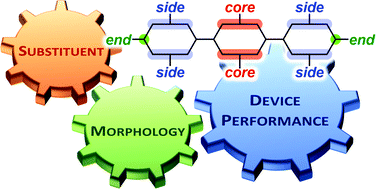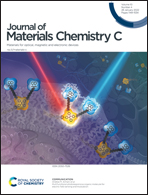Impact of substituents on the performance of small-molecule semiconductors in organic photovoltaic devices via regulating morphology
Abstract
Recent years have witnessed a rapid development of organic photovoltaic devices (OPVs). The significant improvement in power conversion efficiency is due to not only the discovery of new π-conjugated frameworks, but also careful substituent engineering to achieve optimal morphology in bulk-heterojunction active layers. Indeed, all aspects of the light-to-electricity conversion in OPVs, such as light absorption, exciton diffusion, and charge-carrier transport, are influenced by the morphological characteristics of active layers. The importance of active-layer morphology on the performance of OPVs has made substituent engineering an increasingly important part of OPV semiconductor design. Herein, we overview recent prominent examples of substituent engineering, focusing on flexible substituents that regulate morphology, rather than the molecular electronic structure, of small-molecule organic semiconductors.



 Please wait while we load your content...
Please wait while we load your content...